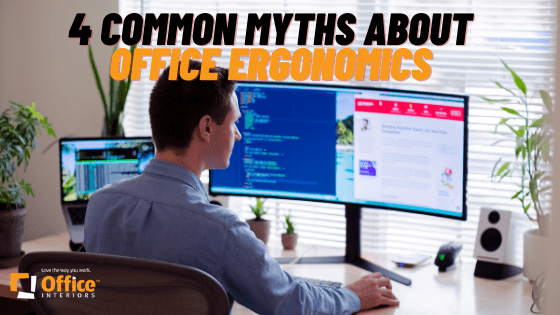When people talk about ergonomics, gimmicky office peripherals and accessories often come to mind. Despite the prevalence of standing desks, split type keyboards, and other ergonomic items, many seem to be stuck with this skewed view of the concept, when in reality, it’s so much more than office accessories.
Our Guide to Office Ergonomics explains how ergonomics delivers value to a business in a variety of ways. Given how it’s all about creating a workstation that provides a healthy and productive work environment, it can lead to healthier, happier, and more comfortable employees.
Ergonomic solutions save people from getting hurt and causing themselves long-term injuries resulting from improper posture while performing their daily tasks. With ergonomic furniture, they are more engaged in their work than being distracted by a poorly designed workstation or chronic pain.
Still, there are myths and misconceptions about ergonomics floating around that can cause many organizations to miss out on the positive impacts of office ergonomics. Here are just some of them:
Myth #1 – Ergonomics is Only For People With Injuries.
Perhaps one of the most dangerous myths about ergonomics is that it is solely for people who have pre-existing musculoskeletal injuries. With how long people at the workplace spend on hunching over their desks throughout the workday, everyone is at risk for injury caused by repetitive actions and awkward postures as they carry out their tasks, proving that everyone can benefit from using ergonomic products.
Ergonomics is not just for people with injuries — it is for people that need to prevent injuries, which is all the employees at the workplace.
The Canadian Centre for Occupational Health and Safety notes that while the workplace seems harmless, musculoskeletal injuries, also called Repetitive Stress Injuries (RSIs), can develop over time, especially for workers who spend the hours upon hours sitting and typing in front of a computer.
Workplace injuries are not sudden events; they sneak up on you over time through muscle overuse and poor posture. With the use of ergonomic office furniture, employees can prevent developing these conditions in the first place.
Myth #2 – Ergonomics Only Has to do With posture.
While it is true that new office furniture helps improve the posture of employees, there is more to ergonomics than investing in a new chair. Pain-Free Working points out that there’s so much more to an ergonomically sound office than posture. It is the way the workplace and equipment work together to elevate the comfort, efficiency, and safety of users. Furniture, regardless of quality, is only one (albeit important) part of the solution.
As we have written previously, providing proper office ergonomics is an excellent way for a company to not only protect its employees but also improve morale. Investing in ergonomic solutions shows that the company cares about the health of their team and can motivate these individuals to work harder, resulting in an increase in productivity and a boost in overall morale.
Myth #3 – There is a One-Size-Fits-All Solution.
The goal of ergonomics is to design a space that works for the individual. There is no such thing as a one-size-fits-all solution. Just because a specific type of mouse works for one employee does not mean that it will automatically work for another.
Occupational Health and Safety highlight how the best way to apply correct ergonomics is through a personalized ergonomic workstation assessment. Investigate each person’s work patterns and personal needs to identify their requirements correctly. These evaluations can either be done with the supervision of a specialist or a designated staff member who has had appropriate training.
Once it comes time to retrofit or replace your team’s furniture, be sure to make education a crucial part of the process. Show your people how to properly adjust their chair (their feet should be lying flat on the floor with their knees at a 90-degree angle), monitor arm (their eyes should be in line with the first row of text on the monitor), and keyboard and mouse.
If you plan on investing in new equipment, ensure that the product should not require strained, repetitive, or awkward postures or motions.
Myth #4 – Ergonomic Furniture is Too Expensive / Not Worth It.
Like any other office product, accessories and peripherals designed with ergonomics in mind have varying price ranges, but investing in them does not mean that you need to blow your company’s budget.
While there are brands that produce expensive ergonomic furniture, the market is also beset with options that can accommodate any budget. Through research and innovation, brands are now able to manufacture ergonomic goods at affordable price points.
Then again, you don’t have to skimp on ergonomic furniture, either. When considering an ergonomic upgrade, consider how the initial cost will eventually prevent or reduce costs in the long run. If employees’ performance is affected by their discomfort or some staff need to take sick, or disability leave to recover from ergonomic injuries, it will affect your company’s productivity, and in turn, your bottom line. If you want to read more about the ROI for ergonomic interventions, take a look at another of our pieces, How Ergonomics Creates Value.
Ready to Improve the Ergonomics of Your Office?
If you are ready to take the next step and would like an ergonomic assessment of your space, request your free assessment today!
Alternatively, if you would prefer to keep learning about ergonomics at your own pace, our Guide to Office Ergonomics is the place to start. We break down everything you need to know if you want to make your workplace a safer, healthier and more productive work environment.
Exclusively written for Office Interiors
By: Rhaine Klaude


